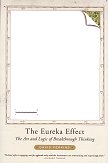Perkins describes the difference between "reasonable" problems -- those where steady progress to a solution can be made by simply continuing to work at it -- and "unreasonable" problems -- those that require some kind of breakthrough thinking to occur. He discusses why these problems differ, and how to recognise ones that need breakthrough events, sub-categorises these into different kinds of breakthrough events, then goes on to suggest ways of arranging the circumstances so that such a breakthrough is more likely to occur.
Searching can be likened to trying to find the highest point in some terrain when it is foggy, so you can see for only a few steps around you. In this analogy, the height of a place represents how good the solution is at that place, so the highest point represents the best solution. Then reasonable problems are like climbing a simple round-topped hill: to get to the top, just walk uphill in whichever is the steepest direction at your current location. [In the search techniques literature, this process is indeed called "hill-climbing".] Perkins likens unreasonable problems to searching for gold in the Klondike. There is a wilderness of possibilities: the search space is vast and the solutions few and hard to find (analogy: a vast amount of terrain, and very few hills). There are clueless plateaus: a large number of nearby possible solution states are all very similar (or possibly all very different) in such a way that they give no clue to the best direction in which to progress (analogy: a vast flat plateau, or very rugged ground, with no obvious hills in sight -- remember, it's foggy, so you can't simply use a telescope to spy out the distant hills!). There are narrow canyons: there is some sort of barrier around the current states (analogy: very few paths or passes out), making it difficult to escape into a better area. And there are false oases: where the solutions are good, but not good enough, and the real solution is a fair way off through a region of less promise (analogy: low hills separated from higher hills by valleys of less promising solutions).
He gives a variety of techniques for breaking out of canyons and away from false oases, including well-known ones such as brainstorming and lateral thinking, and for moving more puposefully in clueless plateaus, such as learning more about the problem (as with Sherlock Holmes' expertise in identifying different cigars' ash) to make tiny clues more apparent. [This would appear to work for the all very similar "plateau" states analogy, but not for the all very different "rugged" states. And very rugged clueless search spaces are quite common.]
He also provides "exercises" to help train the breakthrough techniques. These tend to be what I would call standard lateral thinking brainteasers, and I don't find them as useful as they might have been. That's partly because, since they are standard problems, I have seem most of them before, in one form or another. And partly because they are small, "closed" problems where you know there is a solution. Yet the tasks they are acting as training for are characterised by being open (it's not clear what is relevant to the problem and what is not: no-one has kindly written down a problem statement containing all and only pertinent information), and by there being no guarantee there is a solution (it's much easier to keep persevering if you know there is an answer to be found, than if you suspect there may not be).
Trick problem caveats aside, this is a useful book. The classification of the different kinds of problem areas is very interesting, as are the corresponding different solution techniques, and the whole book is written in a very readable manner.
